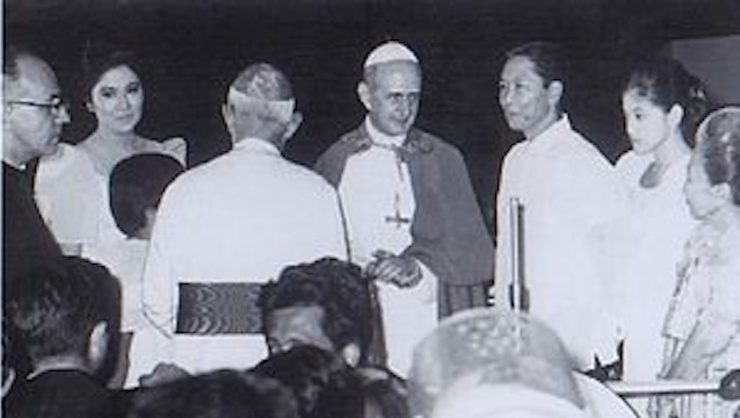SUMMARY
This is AI generated summarization, which may have errors. For context, always refer to the full article.

MANILA, Philippines – Pope Francis’ Philippine itinerary includes the town of Tacloban in Leyte to meet with the victims of Super Typhoon Yolanda (Haiyan).
It was one of the towns badly hit by the strong typhoon, which struck the country in November 2013. More than a year after the storm, the Pope will get to see how the area and its people have recovered.
This is not the first time that a pope’s visit to the Philippines is adopting a disaster theme.
In 1970, Pope Paul VI arrived in the country for the first-ever papal visit. By the time of the visit, the country had just survived the so-called “triplet storms” of that year:
-
Typhoon Sening (Joan), October 11 to 15. The typhoon reportedly had a speed of up to 275 kph and hit several areas like Albay, Camarines Sur, Laguna, Cavite, and the National Capital Region. For 36 years (1970-2006), it kept its record of being the strongest typhoon in the Philippines.
-
Typhoon Titang (Kate), October 16 to 23. With winds of up to 95 kph, it was a small but concentrated typhoon. It was named one of the worst typhoons in Mindanao after causing severe damage in Davao and neighboring provinces, and leaving more than 1,500 people dead. (READ: Worst natural disasters in the Philippines)
-
Typhoon Yoling (Patsy), November 19. Just days before the papal visit, the typhoon struck with winds as strong as 200 kph. It was the strongest typhoon to hit Manila before Typhoon Ondoy of 2009.
Yoling was the most remarkable, as it struck the country’s capital just a few days before the pope arrived. Incidentally, Pope Paul VI’s itinerary was focused only on Manila.
Manila Archbishop Luis Antonio Cardinal Tagle recalled the situation in Manila back then: “Trees that had been denuded, no leaves at all, streets that were cleaned up hastily for the coming of the Pope, roads that had been paved again.” (READ: From Pope Paul VI to Francis, theme in PH visits continues)
See here some photos of areas in Metro Manila right after Yoling hit the country.
The destruction caused by Yoling forced then president Ferdinand Marcos to declare just few days before the papal visit a state of calamity in the provinces of Rizal and Bataan, and in the cities of Manila, Caloocan, Quezon and Pasay.
On November 21, Marcos reported receiving this message from the Pontiff himself:
WITH PROFOUND SORROW WE HAVE LEARNED OF THE DESTRUCTION CAUSED BY A VIOLENT TYPHOON TO THE BELOVED COUNTRY WE ARE SOON TO VISIT STOP WE ASSURE YOUR EXCELLENCY AND THROUGH YOU THE FILIPINO PEOPLE OF OUR DEEPEST SYMPATHY IN THIS TIME OF TRIAL AND OUR FERVENT PRAYERS FOR THE VICTIMS OF THE DISASTER AND THEIR GRIEVING FAMILIES.
Vatican City also donated $10,000 for relief efforts.
On November 27, Marcos welcomed Pope Paul VI and claimed in his welcome remarks that the pope came “at a time of trial, of deep sorrow and deprivation as a result of a natural calamity which reminds us that all of us are in the hands of God.”
Tagle said that after being hit by typhoons, people back then still welcomed Pope Paul VI “like a grace from Heaven.”
Both Popes Paul VI and Francis arrived in Manila under a fair weather. But Pope Francis is expected to be greeted with a rainy weather in Leyte due to Tropical Storm Amang (international name Mekkhala). – Rappler.com
Sources: typhoon2000.com, gov.ph, various news sites
Add a comment
How does this make you feel?
There are no comments yet. Add your comment to start the conversation.